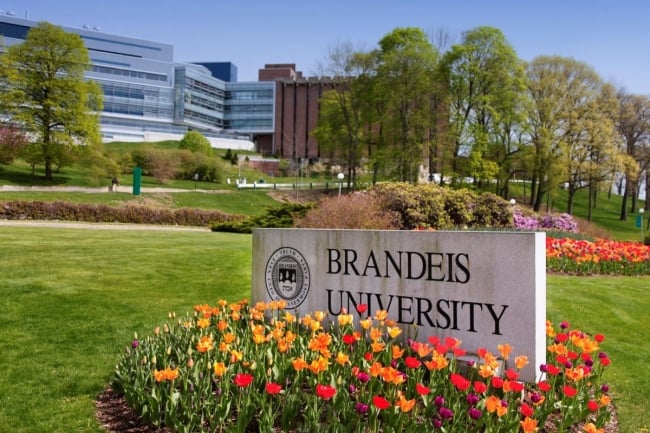You have /5 articles left.
Sign up for a free account or log in.

Brandeis University
Brandeis University may have become the first American higher education institution to address a largely hidden form of prejudice among some students when it announced this week that it would add caste to its nondiscrimination policy.
Brandeis already explicitly prohibited discrimination based on sex, race, nationality, religion and sexual orientation, among other identities. President Ron Liebowitz announced on Tuesday that the private research university in Massachusetts had added caste, a social hierarchy that exists in some South Asian communities, to further protect its diverse student body, faculty and staff.
"Brandeis believes that since caste identity is so intertwined with many of the legally recognized and protected characteristics, discrimination based on a person's caste is effectively the same," Liebowitz said a written statement. "Going forward, the Office of Equal Opportunity will oversee issues and complaints of discrimination related to caste brought forward by members of the Brandeis community, just as it does for other types of discrimination."
The decision was not made because of any specific incidents of caste discrimination on campus, said Mark Brimhall-Vargas, the university's chief diversity officer, but university administrators have heard from students and faculty members of South Asian descent that caste distinctions were present.
“We had an awareness that this was an issue that impacted our campus and that the current policy addressing discrimination wasn’t prepared to address caste,” he said. “It’s simply the right thing to do.”
Brimhall-Vargas said Brandeis was being proactive by addressing the issue of caste discrimination before it became a problem on the campus. He said other colleges that want to create an environment free of harassment and discrimination should also try to get ahead of such issues.
The caste system is a centuries-old social hierarchy that has led to oppression of people in lower castes in some South Asian communities, most notably in India, according to Equality Labs, an international South Asian human rights organization. Prejudices associated with caste also exist outside that part of the world in South Asian immigrant communities in the United States and elsewhere, said Steven Ramey, a professor at the University of Alabama who studies religion in Indian American communities.
Brandeis enrolled 5,800 graduate and undergraduate students in fall 2018, according to its most recent demographic data. Nearly 11 percent of students identified as Asian, and 90 of the university’s 1,571 international students in 2018 were from India, a university spokesperson said in an email. Indians are one of the largest immigrant groups in the greater Boston metro area, where Brandeis is located.
The university already protects students against religious and race-based discrimination, which can be closely tied to a person’s caste distinction, according to Equality Labs. But during discussions on how to add caste to the discrimination policy, Brandeis determined it is a unique classification that transcends race, nationality and religion and has different social implications, Brimhall-Vargas said.
“In general, caste becomes a complicated issue because it’s not typically people from a different community -- not anybody who identifies as Christian or Jewish or Muslim discriminating against Hindus because of their caste,” Ramey said. “It’s typically someone with the same religion, someone with the same nationality. You can’t call it religious or ethnic discrimination because those people fall into the same categories … It doesn’t fit neatly into the other categories.”
In the same way that American racism is not consistent in all white communities, caste discrimination is not present in all Indian American communities, Ramey said. Caste can be identified by a person’s surname or religion or the foods one eats. It can also be identified by the region a person is from and sometimes by the clothes one wears, said Laurence Simon, a South Asian studies professor and director of the Center for Global Development and Sustainability at Brandeis. Simon worked with a committee mostly comprised of students and faculty members with Indian ancestry over the last year to address caste in the university’s nondiscrimination policy.
“Caste is a very powerful indicator of social status and opportunities mostly in South Asian countries, but also in the diaspora of Asian countries in the U.S., and it’s largely hidden,” Simon said. “There’s a sense of caste that’s very ancient but very present … I wouldn’t be surprised if there are other universities in the U.S. where an understanding of caste is held by people in the campus communities.”
Dalits, formerly called “untouchables,” are a class outside the caste system that have historically endured harsh social and economic discrimination, according to Equality Labs. Some Dalits decide to “reclaim” their names and go by their initials so they cannot be identified by their family name, Simon said. In some South Asian communities, Dalits are viewed as less valuable, less intelligent and less moral, Ramey said.
“I could see that type of discrimination coming up in potential admissions cases, or in interactions,” Ramey said. “Because you assume based on the last name or caste background that they have a specific character to them.”
Unless one is a member of a community that recognizes caste, the discrimination is likely not visible, Simon said. Simon said that during his decades of research work in India, he was surprised at “how powerful caste identities still were and how a sense of privilege or exclusion derived from them.”
“The concept of caste and caste discrimination is not something to which most Americans are attuned, and therefore even discrimination might be hidden to our eyes,” said Simon.
In a 2016 survey of South Asian Americans, Equality Labs found that many of the 1,500 respondents reported discrimination by fellow South Asians based on caste. When students of a higher caste learn their peer is of a lower caste, they will “immediately ask to move to other living quarters, forbid cooking of nonvegetarian food, or socially exclude them from South Asian student groups and professional networking circles,” a summary of the survey's results said.
Discrimination is especially present among graduate students because of the high number of first- and second-generation immigrants enrolled in American graduate schools, the survey found.
Both Simon and Brimhall-Vargas said they suspect discrimination based on caste is present at other American colleges. They said they have received positive feedback about the inclusion of caste in the antidiscrimination policy from other college administrators and professors who study caste and are interested in adding caste discrimination to their own antidiscrimination and educational equity policies. Brandeis’s Office of Equal Opportunity, which was established in 2018, will continue to have conversations about caste with the larger student body to ensure it is widely understood, Brimhall-Vargas said.
“We’re an educational institution, and we’re going to drive the conversation in an educational way,” Simon said.




